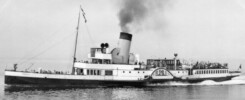
The ever indefatigable Mrs Eileen Pritchard (PSPS Member number 1) organised a visit to the Royal Maritime Auxiliary Service Paddle Tug Grinder at Portsmouth for 11am on Saturday 2nd October 1965. Our group met at the Dockyard’s Main Gate only to receive the bad news from the Dockyard’s Master Rigger that a visit alongside was not possible as Grinder was out in the harbour assisting the movement of one of the “Wave” class fleet oilers. The disappointment that this created was soon dispersed when he went on to say that, instead, we would be taken out in a harbour launch and put aboard during the tow. This we had not expected and was cause for great happiness.
On boarding, the crew of the Grinder were more than helpful giving us a tour of the ship including the very noisy Diesel electric engine room and the bridge which was fitted with an array of electronic kit unheard of on excursion paddlers of the day including bridge control of the engines.
The Wessex Branch had visited Grinder before with a report in an earlier edition of Paddle Wheels having been written by Peter Lamb. However Peter wasn’t available on this day so Mrs Pritchard asked me to write the report instead. That was one of Mrs Pritchard’s great strengths. I was only 14 in 1965. Peter was only slightly older. But still she handed out responsibility and so drew us in to rise to the challenge despite our young age. I never felt that I was ever regarded or treated as a “Junior” member (a category of membership which in any case didn’t exist in 1965) shunted off into some “Junior” section with nice colouring in books to encourage an interest. There I was, along with other youngsters, actually writing reports of events for the Society’s in house magazine. That’s how it was and it cemented our interest.


Grinder was one of seven Diesel-electric paddle tugs built for the Royal Maritime Auxiliary Service between 1956 and 1958. They had independent paddle wheels which made them very manoeuvrable and their massive beam, for the size of vessel, allowed them to tuck under overhanging structures of big ships like aircraft carriers without knocking their funnels off.
The late Captain Bill Hannan, who commanded numerous Royal Maritime Auxiliary Service tugs including Grinder’s sister, Faithful, recalled that the electric drive provided a very quick response to the direct bridge controls which made these tugs “a joy to handle.”
Although others amongst the seven were initially stationed elsewhere, including at Malta, Gibraltar, Devonport and Rosyth, Grinder was based at Portsmouth for her whole career. In December 1979 she was sold to Harry Pound of Portsmouth for scrap but he sold her on and she was broken up at Gijon in Spain the following year.
Kingswear Castle returned to service in 2023 after the first part of a major rebuild which is designed to set her up for the next 25 years running on the River Dart. The Paddle Steamer Kingswear Castle Trust is now fund raising for the second phase of the rebuild. You can read more about the rebuilds and how you can help if you can here.
John Megoran
This article was first published on 2nd October 2020.


